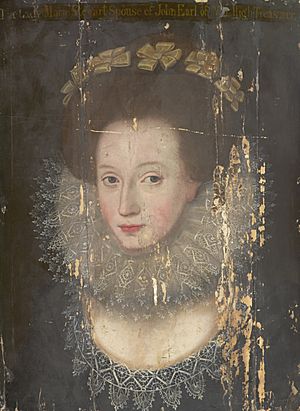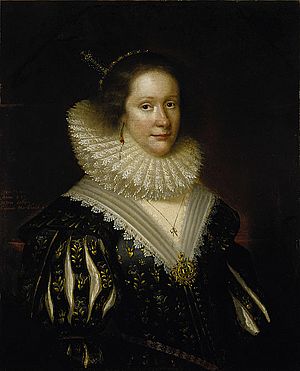Marie Stewart, Countess of Mar facts for kids

Marie Stewart, Countess of Mar (1576-1644) was an important Scottish noblewoman. She was the daughter of Esmé Stewart, 1st Duke of Lennox, who was a close friend of James VI of Scotland. Her mother was Catherine de Balsac. In Scotland, it was common for women not to change their last name after marriage, so Marie continued to sign her letters as "Marie Stuart".
Contents
Marie's Marriage and Faith
When Marie was young, around seven years old, King James VI suggested she might marry someone important.
In 1587, Marie came to Scotland with her older sister Henrietta and her brother Ludovic. Henrietta later married George Gordon, 1st Marquess of Huntly.
Marie became a lady-in-waiting to Anne of Denmark, who was the queen of King James VI, in 1590. This was a special role, helping the queen with her daily life and attending court events. The queen showed her favor by ordering matching orange gowns for herself, Marie, and another lady.
In December 1592, Marie married John Erskine, the Earl of Mar. He was a widower and older than her. The wedding was a big event, first planned for Dalkeith Palace, but held at Holyrood Palace and Alloa Tower in December. King James and Queen Anne gave her beautiful clothes, including a wedding gown that sparkled with gold and silver. Queen Anne even performed in a special play called a masque during the celebrations.
Marie was born Catholic. The Kirk of Scotland (the Scottish Protestant church) encouraged her husband to help her become Protestant. She was taught by a minister named Patrick Simson. She was considered a very good convert. A book of meditations was even dedicated to her, praising her kindness and faith.
Life at Court and Family Matters
Marie Stewart was often at court. In May 1593, she joined Queen Anne and other ladies to visit a Danish ship in Leith. The sailors were given gold coins.
In October 1593, her brother-in-law, the Earl of Huntly, visited her at Brechin Castle. King James VI gave Marie a ring with 11 diamonds in 1595, likely after the birth of her son, who was baptized with the king as a godfather.
Marie and her sister Henrietta were Dames of Honour at the christening of Prince Charles in 1600.
Marie was involved in the politics of the court, supporting her husband and her sister's family. In 1595, she visited Queen Anne at Linlithgow Palace, hoping the queen would help her husband's political group.
In May 1603, Queen Anne of Denmark came to Stirling Castle. She wanted to take her son, Prince Henry, who was being looked after by the Earl of Mar and his family. The Earl of Mar was away with King James VI, who was traveling to London to become King of England. Queen Anne became very upset and fainted, having a miscarriage. Some people believe this incident happened with Marie Stewart, while others think it was with the Earl of Mar's late mother.
Marie remained friends with other courtiers, like Elizabeth Schaw. Marie also helped her husband manage their family's affairs. In 1608, her husband left her a special jewel in his will and named her as the person to look after their children if he died.
After her husband passed away in 1634, Marie had some disagreements with her stepson, the new Earl of Mar, about family property and other issues. She also supported the Solemn League and Covenant, which was an agreement to protect the Presbyterian Church in Scotland. Three of her sons even joined the Covenanter army in 1639.
Marie died in Edinburgh on May 11, 1644, after a short illness.
Marie's Legacy and Writings
Many letters written by Marie Stewart still exist today. They are kept in the National Library of Scotland. She wrote to her son Charles in 1639, saying she looked forward to his visit. She also corresponded with important people like the minister Alexander Henderson and the poet David Murray of Gorthy.
Marie was a supporter of the calligrapher and artist Esther Inglis. In 1622, Inglis created a drawing for Marie, showing a "wise woman who builds her house." This drawing honored Marie's strong faith.
Marie also kept a detailed record of her household expenses. This book, called Extracts from the Household Book of Lady Marie Stewart, shows what life was like in her home. It records payments to Highland singers, pipers, drummers, and harpers, showing her love for music. It also shows her charitable gifts to the poor. A musical instrument called a virginal, which is like a small harpsichord, that belonged to Marie is now in the National Museum of Scotland.
Marie lived in several homes in Scotland, including Stirling Castle, Mar's Wark, Alloa Tower, and Brechin Castle. She even hosted the famous writer John Taylor the Water Poet and King James himself at Brechin Castle in 1617.
Family
Marie Stewart and the Earl of Mar had ten children:
- James Erskine (died 1640), who became the Earl of Buchan.
- Henry Erskine (died 1628), who married Margaret Bannatyne or Bellenden.
- Charles Erskine of Bandeath and Alva, who married Mary Hope.
- Arthur Erskine of Scotscraig (died 1651), who was killed in a battle.
- John Erskine (died 1640), who died in an explosion at Dunglass Castle.
- Alexander Erskine (died 1640), who also died in the explosion at Dunglass Castle.
- Mary Erskine, who married William Keith, 6th Earl Marischal and later Patrick Maule, 1st Earl of Panmure.
- Anna Erskine (died 1640), who married John Leslie, 6th Earl of Rothes.
- Margaret Erskine.
- Annabella Erskine, who married John Lyon, 2nd Earl of Kinghorne.
- Catherine Erskine, who married Thomas Hamilton, 2nd Earl of Haddington. She died in 1635. Her husband also died in the explosion at Dunglass Castle in 1640.
In 1616, two of her children, Anna and James, had their weddings in the same week. Later, her sons Henry and Alexander traveled to France to visit their grandmother, Catherine de Balsac.


